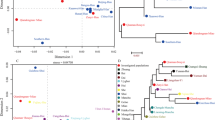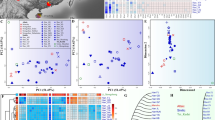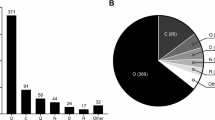Abstract
The ability to extract mitochondrial and nuclear DNA from ancient remains has enabled the study of ancient DNA, a legitimate field for over 20 years now. Recently, Y chromosome genotyping has begun to be applied to ancient DNA. The Y chromosome haplogroup in East Asia has since caught the attention of molecular anthropologists, as it is one of the most ethnic-related genetic markers of the region. In this paper, the Y chromosome haplogroup of DNA from ancient East Asians was examined, in order to genetically link them to modern populations. Fifty-six human remains were sampled from five archaeological sites, primarily along the Yangtze River. Strict criteria were followed to eliminate potential contamination. Five SNPs from the Y chromosome were successfully amplified from most of the samples, with at least 62.5% of the samples belonging to the O haplogroup, similar to the frequency for modern East Asian populations. A high frequency of O1 was found in Liangzhu Culture sites around the mouth of the Yangtze River, linking this culture to modern Austronesian and Daic populations. A rare haplogroup, O3d, was found at the Daxi site in the middle reaches of the Yangtze River, indicating that the Daxi people might be the ancestors of modern Hmong-Mien populations, which show only small traces of O3d today. Noticeable genetic segregation was observed among the prehistoric cultures, demonstrating the genetic foundation of the multiple origins of the Chinese Civilization.

Similar content being viewed by others
Explore related subjects
Discover the latest articles and news from researchers in related subjects, suggested using machine learning.References
Béraud-Colomb E, Roubin R, Martin J, Maroc N, Gardeisen A, Trabuchet G, Goossens M (1995) Human P-globin gene polymorphisms characterized in DNA extracted from ancient bones 12,000 years old. Am J Hum Genet 57:1267–1274
Bouakaze C, Keyser C, Amory S, Crubézy E, Ludes B (2007) First successful assay of Y-SNP typing by SNaPshot minisequencing on ancient DNA. Int J Legal Med (in press)
Chinese State Administration of Culture Heritage (1998) Discovery of archaeology in Three Gorges: the third excavation at Wushan Daxi Site. Hubei Science and Technology Press, Wuhan
Cooper A, Poinar HN (2000) Ancient DNA: do it right or not at all. Science 289:1139
Dalton R (2006) Neanderthal DNA yields to genome foray. Nature 441(7091):260–261
Feng H (2007) General history of Yao Nationality (Yaozu Tongshi). Minzu Press, Beijing
Fily ML, Crubézy E, Courtaud P, Keyser C, Ebrard D, Ludes B (1998) Analyse paléogénétique des sujets de la grotte sépulcrale d’Elzarreko Karbia (Bronze ancien, Pays Basque). CR Acad Sci III(321):79–85
Gilbert MT, Willerslev E, Hansen AJ, Barnes I, Rudbeck L, Lynnerup N, Cooper A (2003) Distribution patterns of postmortem damage in human mitochondrial DNA. Am J Hum Genet 72:32–47
Gilbert MT, Bandelt HJ, Hofreiter M, Barnes I (2005) Assessing ancient DNA studies. Trends Ecol Evol 20:541–544
Higuchi R, Bowman B, Freiberger M, Ryder OA, Wilson AC (1984) DNA sequences from the quagga, an extinct member of the horse family. Nature 312:282–284
Hofreiter M, Serre D, Poinar HN, Kuch M, Pääbo S (2001) Ancient DNA. Nat Rev Genet 2:353–359
Hummel S, Herrmann B (1991) Y-chromosome-specific DNA amplified in ancient human bone. Naturwissenschaften 78(6):266–267
Ke Y, Su B, Xiao J, Chen H, Huang W, Chen Z, Chu J, Tan J, Jin L, Lu D (2001) Y-chromosome haplotype distribution in Han Chinese populations and modern human origin in East Asians. Sci China C Life Sci 44:225–232
Keyser-Tracqui C, Crubezy E, Ludes B (2003) Nuclear and mitochondrial DNA analysis of a 2,000-year-old necropolis in the Egyin Gol Valley of Mongolia. Am J Hum Genet 73(2):247–260
Kuch M, Grocke DR, Knyf MC, Gilbert MT, Younghusband B, Young T, Marshall I, Willerslev E, Stoneking M, Poinar H (2007) A preliminary analysis of the DNA and diet of the extinct Beothuk: a systematic approach to ancient human DNA. Am J Phys Anthropol 132(4):594–604
Lawlor DA, Dickel CD, Hauswirth WW, Parham P (1991) Ancient HLA genes from 7,500-year-old archaeological remains. Nature 349(6312):785–788
Li H (2005) Genetic structure of Austro-Tai populations. Ph.D. dissertation of Human Biology, Fudan University, Shanghai
Murail P, Bruzek J, Braga J (1999) A new approach to sexual diagnosis in past populations: practical adjustments from Van Vark’s procedure. Int J Osteoarchaeol 9:39–53
Pääbo S (1985) Molecular cloning of ancient Egyptian mummy DNA. Nature 314:644–645
Pääbo S (1989) Ancient DNA; extraction, characterization, molecular cloning and enzymatic amplification. Proc Natl Acad Sci USA 86:1939–1943
Pääbo S, Poinar H, Serre D, Jaenicke-Despres V, Hebler J, Rohland N, Kuch M, Krause J, Vigilant L, Hofreiter M (2004) Genetic analyses from ancient DNA. Annu Rev Genet 38:645–679
Peng M-h (2005) Culture research about Wucheng. Wenwu Press, Beijing
Pruvost M, Schwarz R, Correia VB, Champlot S, Braguier S, Morel N, Fernandez-Jalvo Y, Grange T, Geigl EM (2007) Freshly excavated fossil bones are best for amplification of ancient DNA. Proc Natl Acad Sci USA 104(3):739–744
Ricaut FX, Fedoseeva A, Keyser-Tracqui C, Crubezy E, Ludes B (2005) Ancient DNA analysis of human neolithic remains found in northeastern Siberia. Am J Phys Anthropol 126(4):458–462
Schultes T, Hummel S, Herrmann B (1999) Amplification of Y-chromosomal STRs from ancient skeletal material. Hum Genet 104:164–166
Serre D, Langaney A, Chech M, Teschler-Nicola M, Paunovic M, Mennecier P, Hofreiter M, Possnert G, Pääbo S (2004) No evidence of Neandertal mtDNA contribution to early modern humans. PLoS Biol 2(3):E57
Shi H, Dong YL, Wen B, Xiao CJ, Underhill PA, Shen PD, Chakraborty R, Jin L, Su B (2005) Y-chromosome evidence of southern origin of the East Asian-specific haplogroup O3-M122. Am J Hum Genet 77(3):408–419
Stoneking M (1995) Ancient DNA: how do you know when you have it and what can you do with it? Am J Hum Genet 57(6):1259–1262
Su BQ (1999) New survey on the origin of Chinese Civilization. SDX Joint Publishing Co, Beijing
Su B, Xiao J, Underhill P, Deka R, Zhang W, Akey J, Huang W, Shen D, Lu D, Luo J, Chu J, Tan J, Shen P, Davis R, Cavalli-Sforza L, Chakraborty R, Xiong M, Du R, Oefner P, Chen Z, Jin L (1999) Y-Chromosome evidence for a northward migration of modern humans into Eastern Asia during the last Ice Age. Am J Hum Genet 65:1718–1724
The Y Chromosome Consortium (2002) A nomenclature system of the tree of human Y-chromosomal binary haplogroup. Genome Res 12:339–348
Wen B, Li H, Lu DR, Song XF, Zhang F, He YG, Li F, Gao Y, Mao XY, Zhang L, Qian J, Tan JZ, Jin JZ, Huang W, Deka R, Su B, Chakraborty R, Jin L (2004) Genetic evidence supports demic diffusion of Han culture. Nature 431:302–305
Zhang F, Su B, Zhang YP, Jin L (2007) Genetic studies of human diversity in East Asia. Philos Trans R Soc Lond B Biol Sci 362:987–995
Zhejiang Institute of Archaeology (1999) Liangzhu Culture researches. Science Press, Beijing
Acknowledgments
The authors thank the CPAM of Shanghai, Zhejiang Institute of Archaeology, Jiangxi Institute of Archaeology and Shanxi Institute of Archaeology for providing the samples.
Author information
Authors and Affiliations
Corresponding author
Rights and permissions
About this article
Cite this article
Li, H., Huang, ., Mustavich, L.F. et al. Y chromosomes of prehistoric people along the Yangtze River. Hum Genet 122, 383–388 (2007). https://doi.org/10.1007/s00439-007-0407-2
Received:
Accepted:
Published:
Issue Date:
DOI: https://doi.org/10.1007/s00439-007-0407-2




